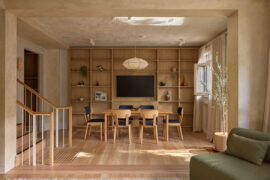Following in the footsteps of the city’s Federation Square, Melbourne’s skyline is changing once more with the Rectangluar Stadium’s bio-frame roof beams being installed. The 31,000-capacity stadium, with a $268 million price tag is expected to generate around $775 million in benefits for construction and associated industries. “Anybody driving or walking the area can really […]
March 10th, 2009
Following in the footsteps of the city’s Federation Square, Melbourne’s skyline is changing once more with the Rectangluar Stadium’s bio-frame roof beams being installed.
The 31,000-capacity stadium, with a $268 million price tag is expected to generate around $775 million in benefits for construction and associated industries.
“Anybody driving or walking the area can really see the stadium’s bio-frame roof coming together. This stadium is not only going to be an excellent sporting arena, it’s also going to stand out as something unique on Melbourne’s skyline,” said Major Projects Minister, Tim Pallas, in a recent statement.
“The bio-frame’s lightweight support structure enables a better use of internal space and will require about 50 per cent less steel than a typical roof structure,” he said.
“The stadium will also feature a world-class playing surface and player’s facilities as well as an associated sports campus with medical facilities and administration offices.”
The project is due for completion in 2010
Click here for more info.
INDESIGN is on instagram
Follow @indesignlive
A searchable and comprehensive guide for specifying leading products and their suppliers
Keep up to date with the latest and greatest from our industry BFF's!

CDK Stone’s Natasha Stengos takes us through its Alexandria Selection Centre, where stone choice becomes a sensory experience – from curated spaces, crafted details and a colour-organised selection floor.

London-based design duo Raw Edges have joined forces with Established & Sons and Tongue & Groove to introduce Wall to Wall – a hand-stained, “living collection” that transforms parquet flooring into a canvas of colour, pattern, and possibility.

Merging residential living with the retail experience, the latest project from In Addition breathes new life into shopping for the home.

Just in from Ontera – the modular carpet manufacturer has achieved full certification to meet the revised standards for the GBCA Best Practice Guidelines for PVC in the Built Environment. To meet the new guidelines an independent assessment is required, effectively replacing the previously accepted Manufacturers Declaration. Meeting the strict requirements of the independent assessment […]
The internet never sleeps! Here's the stuff you might have missed

Celebrating six decades of architectural excellence, the Commonwealth Association of Architects launches a year-long campaign.

Sydney Open invites the public to explore over 55 buildings, spaces and new additions to the skyline, with a newly released Talks & Tours program offering direct access to the architects behind Bundarra and Pier Pavilion.